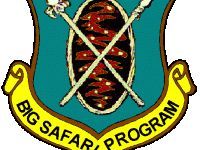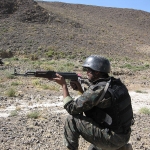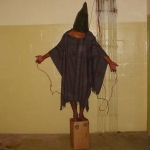Drone, Inc. - L. No Bid Deals & Revolving Doors

While many contractors in the drone program are simply hardware and software manufacturers or suppliers of service personnel, others are deeply involved in the development of new technology. These companies, frequently headed by former senior Pentagon executives, are often awarded contracts without having to compete.
Big Safari
Perhaps the key player in this business is 645th Aeronautical Systems Group, a secretive Air Force technology contracting program. Nicknamed Big Safari, it operates out of the Wright-Patterson base in Dayton, Ohio. 258
258
Created during the Cold War to help the United States spy on the Soviet bloc, Big Safari claims that it has the legal authority to bypass most military bureaucracy including competitive bidding requirements. The first project the group managed was the so-called Boston Camera. With a 240-inch focal-length lens, the three-ton camera was hidden inside a cargo aircraft named Pie Face. Built in 1952 to be flown over East Germany and operated for ten years, the camera was plagued with vibration problems and the images it shot were often covered with smears. 259
259
Beginning in 2001, Big Safari brought together Raytheon and General Atomics to put a sensor system on the Predator (as described in the introduction). 260 Over the last 16 years, Big Safari has been busy handing out new drone development contracts. “We work some of the department’s most sensitive projects and they are all along the lines of intelligence, surveillance and reconnaissance operations,” Col. Edward Topps, commander of the group between 2010 and 2014, told Vocativ website.261
260 Over the last 16 years, Big Safari has been busy handing out new drone development contracts. “We work some of the department’s most sensitive projects and they are all along the lines of intelligence, surveillance and reconnaissance operations,” Col. Edward Topps, commander of the group between 2010 and 2014, told Vocativ website.261
Between 2005 and 2012, Big Safari awarded $31 billion in contracts, Vocativ calculated and estimated that some 96 percent of the money was awarded without competition.262 One of the big winners was Nevada-based Sierra Nevada Corporation, which was given $3.5 billion in contracts over a seven-year period. In addition to manufacturing Airhandler and Gilgamesh phone-location devices and managing piloted surveillance programs in Africa, Sierra Nevada was also paid to develop the Gorgon Stare program—a nine-camera array designed, not unlike the Boston Camera, to photograph an entire city.263
“By dispensing with what its leaders disdained as ‘administrivia’ and working hand-in-glove with defense contractors and the operators of its aircraft … Big Safari could get innovative gear into action within months, weeks and sometimes even days,” writes Richard Whittle in Predator. 264
264
But six decades after Big Safari put the first giant eye into the skies, critics are still complaining about the quality of the imagery produced by these massive surveillance systems, according to a draft audit of the project uncovered by Winslow Wheeler, then-director of the Straus Military Reform Project at the Center for Defense Information.265
Big Safari is able to run legal rings around the Pentagon’s own bureaucracy via Quick Reaction Capabilities (QRC), a mechanism intended for emergency situations as an alternative to the normal “Program of Record” system. Many QRCs, like Boston Camera and Gorgon Stare, fail initial testing just as quickly as they were set up.
Other branches of the military also use QRCs and experiment with new drone technology, for example, the Navy’s Division 312— the Electronics, Sensors and Networks arm of the Office of Naval Research (ONR), headquartered in Arlington, Virginia. Supporting ONR, is the office of Small Business Innovation Research (SBIR) that has funded projects like Ticom Geomatics Dragonfly, and ISRNet (described earlier).266
PEO IEW&S
The Army equivalent of Big Safari is the Program Executive Office for Intelligence, Electronic Warfare & Sensors (PEO IEW&S) at Aberdeen Proving Ground in Maryland267 and it, too, has a less-than-stellar record in producing intelligence gathering technology. The office memorably spent $902 million over nine years to develop the Ground Based Common Sensor Program. GBCS was envisaged as a radio listening station that could be parachuted into war zones and assembled in less than eight minutes. First commissioned to E-Systems, a division of Raytheon, and then to Loral, a division of Lockheed, GBCS was finally canceled in 1999 after a series of scathing audits.268
“The Ground Based Common Sensor Program was not managed efficiently and effectively,” a July 26, 1999 report from the Pentagon’s Inspector General charged. “The GBCS System was not able to reliably receive, record, or determine the direction of conventional or low-probability-of-intercept signals. Test results, also, indicated that the GBCS System was not rapidly deployable or highly mobile.”269
The Pentagon replaced the GBCS with the Prophet, an imposing “all weather, near-real-time, ground-based, tactical signals intelligence/electronic warfare” armored vehicle that could be driven anywhere to listen for enemy chatter.270 But that seems to have fared little better. Shane Harris, author of @War, summed up the program in 2004 simply: “Military intelligence units ... were using the Prophet not to collect signals but to transport food and other material around the base.” 271
271
Part of the problem was that by the time the physically imposing Prophet was ready to be driven around cities (where it stuck out like a sore thumb), nobody was still using push-to-talk radios. The entire world, civilians and insurgents alike, were communicating with mobile phones and the internet, signals that the Prophet was not designed to intercept.
Task Force ODIN
In Norse mythology, Odin is the one-eyed god of war and death who leads a noisy band of slain warriors across the sky. Legend has it that he left his other eye in the well of wisdom so that he could see and know everything.
In August 2006, Army Gen. Richard Cody created an unmanned aviation battalion that adopted the Norse name as an acronym for Task Force Observe, Detect, Identify, and Neutralize (TF ODIN) as a field component to PEO IEW&S.
To this day, the ODIN battalion has big dreams for the future. “Big Safari offers a single program office for cradle-to-grave management of the Air Force’s QRC special projects. It is [the Program Manager of Observe, Detect, Identify]’s long term vision to become the Army´s Big Safari,” wrote Lt. Col. Moises Gutierrez, commander of the program in 2012.272
Strip away the military jargon, and what the Observe, Detect, Identify office wants is the opportunity to conduct real-world experiments with new drone technology in the battle field without the usual bureaucracy and oversight.
But an assessment of ODIN’s experiments depends on how one evaluates its accomplishments.
In the early years of the war in Iraq, ODIN used Warrior Alpha drones, also manufactured by General Atomics, to track down weapons suppliers in Iraq. Such programs are very hard to assess, but a cache of documents released by Wikileaks in 2011, did shed light on at least one: Operation Seventh Veil.273
“The idea [behind] Seventh Veil is … to understand weapons trafficking systems. It allowed us to understand who were the key players within the networks that were operating in our area of responsibility that we needed to go after. And it gave us legitimate cause to go after some of these players,” Col. JB Burton, who took part in a 2007 operations, told the Institute for the Study of War.274
In September 2009, Operation Seventh Veil was used to track alleged weapons smugglers purportedly entering the country from Syria. Yet, half of the 22 reports filed after two months of careful surveillance sum up their experiences as “ineffective.” The others do not evaluate the surveillance operations, but not one weapons smuggler was arrested as a result of the operation.275
On September 5, the military requested that F-16 jets be deployed under Operation Seventh Veil to perform “close air support” to monitor eight individuals crossing the border. When the planes swooped down for a better look, they were very disappointed. “At approximately 0220, CAS also identified large flocks of sheep in the vicinity of the individuals. We assess the individuals are shepherds and were moving their flocks,” the log records.276
Pretty soon, the Warrior Alpha drone picked up some more individuals, who were unloading boxes from a group of donkeys. The Airborne Infantry was dispatched to help the local Iraqi police arrest the individuals. “425 LRS arrive on scene and identify the items as cartons of cigarettes … no foreigners found. … This was a cigarette-smuggling attempt into Syria.”277
| Revolving Doors The Big Safari procurement program appears to have paid off well for Col. Edward Topps and Lt. Col. Kevin “Ducky” Hoffmann, the two men in charge of developing armed and networked drones in 2001.
Hoffman, who was program manager for the MTS-A and the Hellfire missile on the Predator and the Reaper, left the Air Force in 2010 to join Intuitive, a Huntsville, Alabama company where his new title was “director of Air Force Programs.”282 In May 2014, Topps retired from running Big Safari for the Air Force. Ten short months later he took up a new job with none less than Sierra Nevada Corporation, one of Big Safari’s top grantees. He is now vice president for programs, according to his own online resume.283 In 2015, Intuitive and Sierra Nevada joined forces to bid on an Air Force contract to build JSTARS surveillance planes.284 |
Not one of the 22 missions found any guns. One of the final reports, filed on October 26, 2009, gave some details on the smugglers. “Brawler along with IBP (Iraqi Border Police) located 8x boxes of cigarettes and detained 1x LN (Local National)… from Rummah. He said he has been smuggling for 10 years to support his family, earning 20USD per delivery, he says he never caries [sic] a weapon.”278
ODIN has claimed more success in tracking down bomb planters, however. In 2006, the unit claimed it had used drones and ground troops in Iraq to kill 2,400 bomb-planters and capture 141.279 The number of roadside bombs plunged, suggesting success. But by 2009, the numbers were back up again.280
Program managers say they had second thoughts later. “’Kill’ isn’t the only answer here. This is a counterinsurgency fight,” Lt. Col. Kevin Diermeier of ODIN told Wired magazine. “You can’t just say, ‘I captured this dude, I killed this dude, I’m making a difference,’ Maj. Jason Periatt added. “I go back to the ’80s. We started rolling up drug dealers. That doesn’t mean you’re necessarily [succeeding].”281
< Previous • Report Index • Download Report • FAQ/Press Materials • Watch Video • Next >



